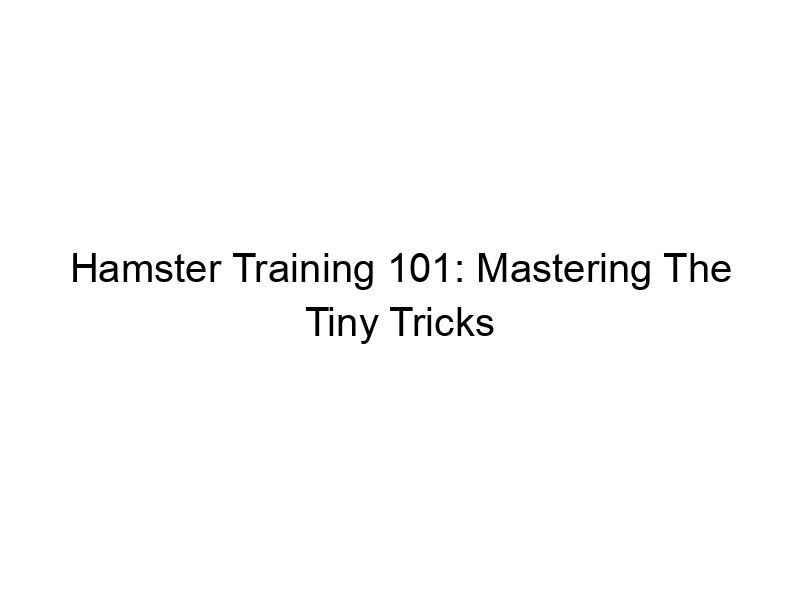Have you ever wondered if your fluffy hamster could learn tricks? It might seem surprising, but hamsters are surprisingly intelligent creatures capable of learning a range of behaviors. Hamster Training 101: How to Teach Your Hamster Fun Tricks is more than just a cute hobby; it’s a fantastic way to bond with your pet, understand their behavior, and enrich their lives. In this comprehensive guide, we’ll explore everything from basic training techniques to advanced tricks, addressing common challenges and providing practical tips to help you and your hamster embark on this exciting journey together. We’ll cover the essentials of positive reinforcement, common trick training methods, and troubleshooting tips, equipping you with the knowledge to create a strong bond with your furry friend.
Hamsters learn through association, much like Pavlov’s famous dogs. They
connect specific actions with positive or negative outcomes. Positive reinforcement, rewarding desired behaviors with treats or praise, is the most effective method. Avoid punishment, which can create fear and anxiety. Understand your hamster’s individual personality; some are bolder and more eager to learn than others. Patience and consistency are key.
Choosing the Right Training Methods
Positive Reinforcement: Rewards Over Punishment
Positive reinforcement focuses on rewarding good behavior. This could involve offering a small piece of sunflower seed, a favorite treat, or even gentle praise and petting. Never use punishment; it’s counterproductive and can damage your relationship with your hamster.
Basic Training Techniques for Hamsters
Starting with the Essentials: Habituation and Handling
Before teaching tricks, your hamster must be comfortable with handling. Start by gently placing your hand in their cage, allowing them to investigate it at their own pace. Gradually increase the duration of handling sessions, rewarding calm behavior.
Advanced Hamster Tricks: Beyond the Basics
Wheel Running on Cue: A Challenging Trick
Training your hamster to run on its wheel on cue requires patience and consistent reinforcement. Initially, associate the wheel with a treat by placing a small amount near it. Then, gently guide your hamster to the wheel and reward it once it starts running.
Troubleshooting Common Training Challenges
Dealing with Stubborn or Fearful Hamsters
Some hamsters may be more resistant to training than others. Patience and consistency are essential. If your hamster seems fearful, ensure a calm and safe training environment. Short, frequent training sessions are better than long, stressful ones.
Enrichment and Training: A Synergistic Approach
Combining Training with Environmental Enrichment
Enrichment activities, like providing tunnels, toys, and foraging opportunities, stimulate your hamster mentally and physically. This enriched environment can positively influence their willingness to participate in training.
The Role of Treats in Hamster Training
Choosing the Right Rewards: Healthy and Appealing
Offer a variety of healthy treats, rotating them to keep your hamster engaged. Sunflower seeds, pumpkin seeds, and small pieces of fruits or vegetables are excellent choices. Avoid sugary treats, as they are unhealthy.
Understanding Your Hamster’s Body Language
Interpreting Signals: Recognizing Stress and Engagement
Pay close attention to your hamster’s body language. Signs of stress include rapid breathing, flattened ears, and hiding. A relaxed hamster will have a relaxed posture and may groom itself. Observe your hamster carefully to adjust your training approach.
Creating a Hamster-Friendly Training Environment
Setting the Stage for Success: A Safe and Comfortable Space
Choose a quiet and comfortable location for training. Ensure the area is free from distractions and potential hazards. Keep training sessions short and sweet to avoid overwhelming your hamster.
Safety First: Avoiding Hamster Training Hazards
Preventing Injuries: Monitoring Your Hamster’s Progress
Always supervise your hamster during training. Be mindful of potential hazards, such as sharp objects or small items that could be swallowed. If your hamster seems stressed or injured, stop training immediately.
Building a Bond Through Training
The Power of Interaction: Strengthening Your Relationship
Hamster training is a fantastic way to build a stronger bond with your pet. It encourages interaction, enhances communication, and helps you understand your hamster’s individual personality.
Comparing Different Training Techniques
A Comparative Analysis: Clicker Training vs. Hand-Feeding
Clicker training uses a clicker to mark desired behaviors, while hand-feeding involves directly rewarding your hamster with treats. Both techniques are effective, but the best approach depends on your hamster’s personality and your preferences.
Setting Realistic Goals and Expectations
Avoiding Frustration: Gradual Progression and Patience
Avoid trying to teach too many tricks at once. Start with simple behaviors and gradually increase the difficulty as your hamster progresses. Be patient; every hamster learns at its own pace.
Hamster Training and Behavioral Issues
Addressing Problem Behaviors: Identifying and Solving
If your hamster displays undesirable behaviors, such as biting or excessive digging, address them calmly and consistently. Consult a veterinarian or a hamster expert if you need assistance.
Maintaining Consistency in Hamster Training
Sustaining Progress: Regular Practice and Reinforcement
Consistent training is crucial for maintaining progress. Schedule regular training sessions, even if they’re just short and simple. Positive reinforcement will strengthen the bond you share with your hamster.
Frequently Asked Questions
What is the best age to start hamster training?
Ideally, start training when your hamster is young and more receptive to learning. Around 8-12 weeks old is a good time, allowing them to acclimate to their new environment before introducing formal training.
How long should hamster training sessions last?
Keep training sessions short and sweet – 5-10 minutes at a time is usually sufficient. Longer sessions can overwhelm your hamster and lead to frustration.
What are some common mistakes to avoid during hamster training?
Avoid using punishment, forcing your hamster to participate, and neglecting positive reinforcement. Also, be aware of your hamster’s body language; signs of stress should be heeded immediately.
Can all hamsters be trained?
While most hamsters can learn tricks, some are more receptive than others. Individual personalities and prior experiences play a role. Persistence and patience are key.
What if my hamster isn’t interested in the treats?
Experiment with different treats until you find something your hamster enjoys. Try small pieces of fruits, vegetables, or high-quality hamster food.
My hamster seems scared; how should I proceed?
If your hamster is scared, stop the training session immediately. Try again another day, ensuring a calm and comfortable environment. Approach slowly and gently.
How do I know if my hamster is stressed during training?
Signs of stress include rapid breathing, flattened ears, hiding, and aggressive behavior. If you see any of these signs, stop training and allow your hamster time to calm down.
Final Thoughts
Training your hamster is a rewarding experience that strengthens the bond between you and your furry friend. It allows for increased interaction, mutual understanding, and a deeper appreciation of your hamster’s intelligence and personality. By following the tips and techniques outlined in this guide, you can successfully teach your hamster fun tricks, enriching both your lives. Remember that patience, positive reinforcement, and understanding your hamster’s individual needs are the keys to success. Start with the basics, celebrate small victories, and enjoy the journey of building a strong and loving relationship with your little companion. So grab your favorite hamster treats, and get ready for some fun!




